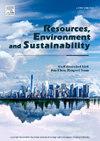蛋白质饲料驱动的猪肠道微生物群调节:减轻气味排放的机制和可持续除臭配方的开发
IF 7.8
Q1 ENVIRONMENTAL SCIENCES
引用次数: 0
摘要
畜牧业在很大程度上造成了人为温室气体排放和恶臭污染物,加剧了全球环境退化。尽管蛋白质饲料在调节气体排放和提高猪肉生产效率方面发挥着至关重要的作用,但不同蛋白质饲料调节气味的机制尚不清楚。本研究通过体外模拟发酵和体内饲养试验,探讨8种中国产蛋白质饲料通过调节猪肠道菌群来缓解猪膻味的效果。结果表明,蛋白质含量和氨基酸组成是影响气味释放的关键因素。值得注意的是,棉籽粕组表现出最高的气味水平(68.67±58.13 ppm),并且显示出Megasphaera属的富集。相关分析显示,Megasphaera与H2S、NH3、H2和CO2的产量呈正相关。KEGG通路分析表明,棉籽粕组代谢途径丰度高于其他试验组,其中巨藻与多种代谢途径呈正相关,包括氨基糖和核苷酸糖代谢。玉米胚芽粕- h组和菜籽粕- j组的气味水平较低(分别为12±5.33 ppm和16.17±6.18 ppm),与芽孢杆菌和未分类芽孢杆菌呈负相关。此外,饲养试验表明,油菜籽粕基饲料在不影响猪生产性能的情况下,可使猪舍内NH3和H2S排放量分别降低47.75%和54.2%。这些发现阐明了蛋白质饲料在气味调节中的作用,为平衡养猪业可持续性和环境退化奠定了科学基础。然而,关键细菌等的气味代谢分子机制仍需深入研究。本文章由计算机程序翻译,如有差异,请以英文原文为准。

Protein feed-driven regulation of pig intestinal microbiota: Mechanisms underlying odor emission mitigation and development of sustainable deodorizing formulations
Livestock farming significantly contributes to anthropogenic greenhouse gas emissions and malodorous pollutants, exacerbating global environmental degradation. Despite the crucial role of protein feeds in regulating gas emissions and enhancing pork production efficiency, the mechanisms by which different protein feeds regulate odors remain unclear. This study employed an in vitro simulated fermentation and in vivo feeding trials to explore the effects of eight protein feeds in China on odor mitigation through regulation of pig gut microbiota. Results demonstrated that protein content and amino acid composition were key factors influencing odor emissions. Notably, the cottonseed meal group exhibited the highest levels of odor (68.67 ± 58.13 ppm) and showed enrichment of the genus Megasphaera. Correlation analysis revealed positive associations between Megasphaera and the production of S, NH3, , and CO2. KEGG pathway analysis indicated that the cottonseed meal group displayed a higher abundance of metabolic pathways compared to other experimental groups, with Megasphaera positively correlating with multiple metabolic pathways, including amino sugar and nucleotide sugar metabolism. In contrast, corn germ meal-H and rapeseed meal-J groups had lower odor levels (12 ± 5.33 ppm and 16.17 ± 6.18 ppm, respectively), negatively associated with Bacillus and unclassified_c__Bacilli. Additionally, feeding trials demonstrated that rapeseed meal-based feed reduced NH3 and S emissions in pig houses by 47.75% and 54.2%, respectively, without compromising pig production performance. These findings clarified protein feeds’ role in odor regulation and laid a scientific foundation for balancing pig industry sustainability and environmental degradation. However, odor metabolism molecular mechanisms in key bacteria and others still require in-depth study.
求助全文
通过发布文献求助,成功后即可免费获取论文全文。
去求助
来源期刊

Resources Environment and Sustainability
Environmental Science-Environmental Science (miscellaneous)
CiteScore
15.10
自引率
0.00%
发文量
41
审稿时长
33 days
 求助内容:
求助内容: 应助结果提醒方式:
应助结果提醒方式:


